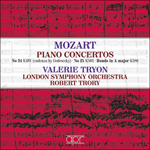
Welcome to Hyperion Records, an independent British classical label devoted to presenting high-quality recordings of music of all styles and from all periods from the twelfth century to the twenty-first.
Hyperion offers both CDs, and downloads in a number of formats. The site is also available in several languages.
Please use the dropdown buttons to set your preferred options, or use the checkbox to accept the defaults.

| Valerie Tryon (piano), London Symphony Orchestra, Robert Trory (conductor)» More |
The qualities of grandeur, virtuosic brilliance and intimacy characteristic of Mozart’s piano concerto style are configured and reconfigured at a key juncture (the first solo participation by the piano), setting the tone for the remainder of the movement. The solo exposition and recapitulation carry some of the most adventurously virtuosic writing in Mozart’s concerto oeuvre as well as tightly interwoven passages for soloist and orchestra, and the development section offers contrapuntal equality among the piano, wind and strings before demonstrative solo material takes hold towards the end.
While the first movement is a hard act to follow, Mozart continues in the andante and the allegretto to negotiate imposing and delicate material. In the andante, a slow-movement sonata form (progressing directly from the exposition to the recapitulation without a development section), the piano receives a greater quantity of virtuosic decoration, embellishment and elaboration than in most of Mozart’s concerto middle movements, and the wind are more prominent than in most corresponding movements as well, both as quasi-soloists and as accompanists. The finale, a long sonata rondo preceded by a substantial orchestral ritornello, brings proceedings to a memorable close with virtuosic fireworks and interactive, timbrally prominent wind.
from notes by Simon P Keefe © 2017
Les caractéristiques de grandeur, de virtuosité brillante et d’intimité typiques du style concertant pour piano de Mozart sont sculptées et resculptées à un moment clé (la première entrée solo du piano), déterminant ainsi la sonorité pour le reste du mouvement. L’exposition et la réexposition sont un exemple de l’écriture la plus audacieusement virtuose dans l’oeuvre concertante pour piano du compositeur, tout comme les passages étroitement entrelacés pour le soliste et l’orchestre ainsi que le développement, qui offre une égalité contrapuntique entre le piano, les vents et les cordes avant que le matériel solo ne prenne le pas jusqu’à la fin.
Tandis que l’action du premier mouvement est difficile à suivre, Mozart continue, dans l’andante et l’allegretto, à utiliser un matériau à la fois imposant et délicat. Dans l’andante, un mouvement lent de forme sonate (progressant directement de l’exposition à la réexposition, sans développement), le piano a à jouer plus d’embellissements, d’ornements et d’élaborations virtuoses que dans la plupart des mouvements centraux des concertos du compositeur; par ailleurs, les vents sont particulièrement présents, dans un rôle à la fois quasi-soliste et d’accompagnement. Le mouvement final, un long rondo précédé par une importante ritournelle orchestrale, mène à une fin remarquable avec des feux d’artifice virtuoses et des vents sonores et en interaction.
extrait des notes rédigées par Simon P Keefe © 2017
Français: Catherine Meeùs
Qualitäten wie Pracht, virtuose Brillanz und Intimität, die für den Klavierkonzertstil Mozarts charakteristisch sind, werden an einer Schlüsselstelle (der ersten solistischen Beteiligung des Klaviers) gestaltet und neu gestaltet und geben den Ton für den restlichen Teil des Satzes an. Die Soloexposition und -reprise bringen nicht nur einige der abenteuerlichsten Beispiele virtuoser Schreibweise in Mozarts Klavierkonzert-Schaffen, sondern auch dicht miteinander verwobene Passagen für Solist und Orchester, und der Durchführungsteil bietet kontrapunktische Gleichbehandlung zwischen dem Klavier, den Holzbläsern und den Streichern, bevor sich dann bis zum Ende hin demonstratives Solo-Material breitmacht.
Während der erste Satz nur schwer zu überbieten ist, fährt Mozart im Andante und dem Allegretto damit fort, repräsentatives und zartes Material zu bewältigen. Im Andante, einem langsamen Sonatensatz (direkt ohne Durchführungsteil von der Exposition in die Reprise fortschreitend), erhält das Klavier eine größere Menge von virtuoser Dekoration, Verzierung und Ausschmückung als in den meisten Binnensätzen von Mozarts Konzerten, und auch die Holzbläser werden prominenter eingesetzt als in den meisten entsprechenden Sätzen, sowohl als Quasi-Solisten wie auch als Begleiter. Das lange Sonatenrondo-Finale, dem ein bedeutendes Orchesterritornell vorausgeht, bringt das Geschehen mit virtuosen Feuerwerken und sich gegenseitig beflügelnden, farblich hervorstechenden Holzbläsern zu einem unvergesslichen Abschluss.
aus dem Begleittext von Simon P Keefe © 2017
Deutsch: Jan Ritterstaedt
 Mozart: Piano Concertos Nos 24 & 25 Mozart: Piano Concertos Nos 24 & 25'[A] simultaneously rich and discreet character in playing of an imperturbable clarity … a marvel of refined brilliance' (Gramophone)» More |

